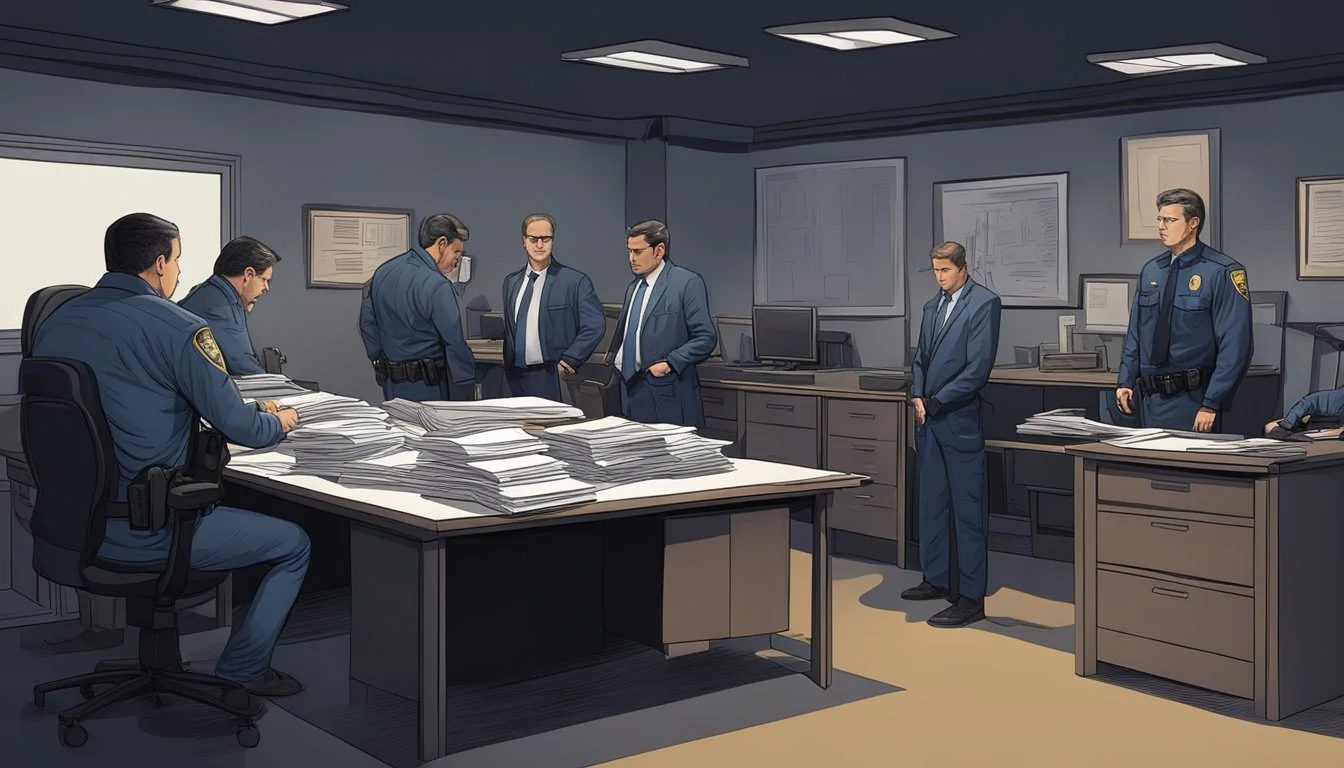Analyzing the Narrative Structure of American Nightmare
A Deep Dive into Alan Wake 2's Storytelling
American Nightmare, a gripping Netflix docuseries, employs a masterful narrative structure to unravel a complex true crime story. The series revisits a controversial case, presenting events through carefully crafted storytelling techniques that engage viewers and challenge preconceptions.
The show's narrative structure expertly weaves together in-depth interviews, archival footage, and recorded evidence to create a compelling and immersive viewing experience. This approach allows for a nuanced exploration of the case, surpassing the depth of initial news coverage. By incorporating multiple perspectives and sources, American Nightmare constructs a multi-layered narrative that encourages viewers to question their assumptions and critically examine the justice system.
Through its thoughtful presentation, American Nightmare sparks important conversations about truth, justice, and societal perceptions. The series demonstrates the power of media in shaping public opinion and highlights the potential consequences of hasty judgments. Its narrative structure serves not only to entertain but also to provoke reflection on broader issues within American society.
American Nightmare in Contemporary Media
The concept of the American Nightmare has gained prominence in modern media, reflecting societal anxieties and disillusionment. This narrative shift explores the darker aspects of American culture, challenging traditional ideals and exposing hidden truths.
The Evolution of the American Nightmare Concept
The American Nightmare emerged as a counterpoint to the optimistic American Dream in mid-20th century literature. Authors like Hunter S. Thompson and Joan Didion explored themes of disillusionment and social decay. This concept has since evolved, adapting to contemporary issues and fears.
In recent years, the American Nightmare has expanded to encompass income inequality, racial injustice, and political polarization. Media portrayals now often focus on the struggles of marginalized groups and the erosion of social institutions.
The narrative has also incorporated elements of technological dystopia, climate anxiety, and economic instability. These themes reflect growing concerns about the future of American society and its values.
Representation in Film and Television
Film and television have become powerful mediums for exploring the American Nightmare. Dramatic series often depict characters grappling with shattered dreams and systemic failures.
Popular shows like "Breaking Bad" and "The Wire" showcase individuals driven to extremes by societal pressures and limited opportunities. These narratives challenge the notion of upward mobility and expose the dark underbelly of American life.
In cinema, films like "Get Out" and "Parasite" use horror and satire to critique social inequality and racial tensions. These works subvert traditional storytelling conventions to highlight pressing issues.
Documentaries and true crime series have also embraced the American Nightmare concept. They often focus on real-life stories that expose flaws in the justice system and societal structures.
Themes and Narrative Devices
American Nightmare utilizes several key themes and narrative techniques to craft its gripping story. Crime, justice, and the quest for resolution drive the plot forward, while flashbacks provide crucial context and depth.
Crime as a Central Motif
Crime permeates every aspect of American Nightmare's narrative. The story revolves around a series of brutal murders that shock the small town setting. These heinous acts serve as the catalyst for the protagonist's investigation and personal journey.
The criminal underworld is vividly portrayed, with shady characters and illicit dealings creating a tense atmosphere. Corruption within law enforcement adds another layer to the crime motif, blurring the lines between right and wrong.
Symbols of crime, such as blood-stained evidence and police tape, recur throughout to reinforce this central theme.
Justice and Resolution in Storytelling
The pursuit of justice propels the story forward. The protagonist faces numerous obstacles in their quest to solve the crimes and bring the perpetrators to account.
Moral dilemmas arise as characters grapple with the complexities of justice. Is vigilantism ever justified? Can the legal system be trusted to deliver true justice?
As the narrative progresses, partial resolutions provide a sense of satisfaction. However, new revelations often complicate matters, maintaining tension until the climactic finale.
The Role of Flashbacks
Flashbacks serve as a crucial narrative device in American Nightmare. These scenes from the past provide essential backstory and character development.
Key events from the protagonist's history are gradually revealed, shedding light on their motivations and personal demons. Flashbacks also offer glimpses into the victims' lives, humanizing them beyond mere plot devices.
The non-linear storytelling created by these flashbacks adds depth and intrigue. Viewers must piece together the full picture as past and present narratives intertwine.
Case Study: The True Crimes of Aaron Quinn and Denise Huskins
The kidnapping of Denise Huskins and subsequent investigation revealed shocking twists that challenged assumptions about victims and law enforcement. This case exposed flaws in the criminal justice system and highlighted the importance of physical evidence in corroborating victim testimonies.
Unfolding the Kidnapping and Aftermath
On March 23, 2015, Denise Huskins was abducted from her boyfriend Aaron Quinn's home in Vallejo, California. Quinn reported waking up to a bright light and masked intruders. The kidnappers drugged Quinn and took Huskins.
Huskins reappeared 48 hours later, 400 miles away in Huntington Beach. Her sudden return raised suspicions among investigators. Law enforcement publicly doubted their story, accusing the couple of orchestrating a hoax.
This skepticism led to severe emotional and legal consequences for Huskins and Quinn. They faced public scrutiny and struggled to convince authorities of their innocence.
Analysis of Law Enforcement Response
The Vallejo Police Department's handling of the case drew criticism. Investigators initially focused on Quinn as a suspect, disregarding his claims about the kidnapping.
Physical evidence supported Quinn's account. Toxicology reports confirmed drugs in his system, aligning with his description of being sedated by the intruders.
Despite this corroborating evidence, law enforcement continued to doubt the couple's story. This misstep allowed the real perpetrator to remain at large for months.
The case exposed flaws in investigative procedures and highlighted the importance of thorough evidence examination before drawing conclusions.
Matthew Muller: The Antagonist's Identity
Months after the kidnapping, the true culprit was identified as Matthew Muller, a former Marine and disbarred Harvard-educated lawyer.
Muller's capture came after a similar home invasion attempt in Dublin, California. DNA evidence linked him to Huskins' kidnapping.
His arrest vindicated Huskins and Quinn, proving their ordeal was real. Muller pleaded guilty to kidnapping and was sentenced to 40 years in federal prison.
The revelation of Muller's identity shed light on the complexity of the crime and the dangers of prematurely dismissing victim testimonies.
The Impact of Real Events on Fictional Narrative
Real events often shape fictional narratives in profound ways. They provide inspiration, authenticity, and emotional resonance to stories across various media. This interplay between fact and fiction creates compelling narratives that captivate audiences.
Influence of the Arizona Incident
The Arizona incident served as a catalyst for the American Nightmare storyline. This real-world event injected a sense of urgency and realism into the fictional narrative. It grounded the story in a recognizable context, allowing viewers to connect more deeply with the characters and their struggles.
The writers incorporated specific details from the incident to enhance the plot's believability. They carefully wove factual elements into the fictional framework, creating a seamless blend of reality and imagination. This approach lent credibility to the story's more fantastical elements.
By anchoring the narrative in a real event, the creators tapped into existing public emotions and concerns. This connection amplified the story's impact and relevance to contemporary audiences.
Literature and True Crime Adaptations
True crime adaptations have gained significant popularity in recent years, particularly on streaming platforms like Netflix. These narratives blur the lines between fact and fiction, offering audiences a unique storytelling experience.
Authors and screenwriters often draw inspiration from real criminal cases. They use these events as a foundation to craft compelling fictional narratives. This approach allows them to explore complex themes and human motivations within a recognizable framework.
True crime adaptations face the challenge of balancing factual accuracy with narrative engagement. Writers must carefully navigate ethical considerations when portraying real people and events. They often employ fictional elements to fill gaps in the factual record or to protect individuals' privacy.
These stories can have a powerful impact on public perception of criminal cases. They sometimes lead to renewed interest in cold cases or bring attention to miscarriages of justice.
Societal Reflection and Criticism
American Nightmare offers a stark portrayal of societal attitudes towards crime, media influence, and sexual assault. The narrative structure illuminates deep-seated issues within the justice system and public discourse.
Societal Views on Crime and Punishment
The film challenges conventional notions of justice and retribution. It depicts a society grappling with the consequences of harsh punitive measures. Characters face moral dilemmas that reflect real-world debates on rehabilitation versus punishment.
The protagonist's journey through the legal system exposes flaws in how crimes are prosecuted and punished. This portrayal prompts viewers to question the effectiveness of current approaches to criminal justice.
Public opinion in the film sways dramatically based on media coverage, mirroring real-world trends in crime perception. The narrative highlights how fear and misinformation can shape punitive attitudes.
Media Discourse and Public Perception
American Nightmare scrutinizes the media's role in shaping public opinion on criminal cases. News outlets in the film sensationalize events, often at the expense of accuracy.
Social media platforms become battlegrounds for competing narratives. The film shows how online discourse can rapidly influence public sentiment and even legal proceedings.
Characters struggle with the consequences of trial by media. Their personal lives are dissected and judged in the court of public opinion, reflecting contemporary concerns about privacy and digital footprints.
Victim Blaming and Sexual Assault
The film tackles the sensitive topic of sexual assault with nuance. It exposes societal tendencies to question and blame victims rather than perpetrators.
Characters face skepticism and hostility when reporting assaults. This reflects real-world challenges faced by survivors in the justice system and society at large.
The narrative explores how gender biases influence perceptions of sexual assault cases. It critiques societal norms that often protect assailants while scrutinizing victims' behaviors and choices.
American Nightmare forces viewers to confront uncomfortable truths about how sexual assault cases are handled in both legal and social contexts.
Cinematographic and Literary Influences
American Nightmare draws inspiration from classic television anthologies and previous works in the Alan Wake universe. These influences shape the game's unique visual style and storytelling approach.
Echoes of Twilight Zone and Night Springs
American Nightmare pays homage to The Twilight Zone, a pioneering science fiction anthology series. The game's episodic structure and narration style mirror the iconic show's format. Night Springs, a fictional TV series within the Alan Wake universe, serves as a direct nod to The Twilight Zone.
The game features black-and-white cutscenes reminiscent of vintage television broadcasts. These segments enhance the eerie atmosphere and reinforce the connection to classic anthology shows.
Night Springs episodes appear as collectibles throughout American Nightmare. These short vignettes offer cryptic insights into the game's world and themes.
The Style of Alan Wake and The Dark Place
American Nightmare builds upon the visual aesthetics established in the original Alan Wake game. The Dark Place, a nightmarish realm central to the series' lore, heavily influences the game's environments.
Shadowy figures and light-based combat mechanics return from Alan Wake. These elements create a distinct visual language that sets American Nightmare apart from typical action games.
The game's Arizona desert setting contrasts with the Pacific Northwest locale of Alan Wake. This shift in scenery allows for new visual motifs while maintaining the series' signature atmosphere.
American Nightmare incorporates more action-oriented gameplay compared to its predecessor. This evolution reflects Alan Wake's growing mastery over The Dark Place and its manifestations.
The Role of Law Enforcement and FBI Agents
Law enforcement and FBI agents played a pivotal role in the American Nightmare case, shaping its trajectory through their investigative actions and decisions. Their handling of the case had significant implications for both the victims and the pursuit of justice.
The Procedure and Investigation Tactics
FBI agents analyzed email communications from the kidnapper, tracing IP addresses and examining digital forensics related to the ransom demands. They initially dismissed the case as a hoax, leading to a series of missteps in the investigation.
Law enforcement agencies prioritized evidence-based approaches, including thorough crime scene processing and preservation of digital records. However, their initial skepticism hindered progress in solving the case.
The collection and analysis of physical evidence proved crucial. Proper handling of forensic data became a make-or-break factor in unraveling the truth behind the kidnapping.
Misty Carausu and the Shift in Perspective
Detective Misty Carausu's involvement marked a turning point in the American Nightmare case. Her fresh perspective and thorough investigation challenged the prevailing narrative.
Carausu's work led to the discovery of crucial DNA evidence, which ultimately vindicated the victims and exposed the flaws in the initial investigation. This new evidence identified the real perpetrator and shifted the focus of the case.
Her efforts highlighted the importance of persistence and attention to detail in criminal investigations. Carausu's role demonstrated how a single detective's work could dramatically alter the course of a complex case.
Reflections on the Intersection of Narrative and Society
Narratives shape societal perceptions and individual identities, while social contexts influence the stories we tell. This interplay manifests in complex ways within the American Nightmare narrative.
The Influence of Narratives on Society and Vice Versa
Narratives act as powerful tools for shaping collective understanding. They frame experiences, define cultural norms, and influence social behavior. In the context of the American Nightmare, narratives of economic struggle and shattered dreams permeate society.
These stories impact policy decisions, public opinion, and individual aspirations. Simultaneously, societal conditions feed back into narratives, reinforcing or challenging existing storylines.
Media, literature, and personal accounts contribute to a shared narrative landscape. This landscape reflects and perpetuates societal anxieties about economic instability, social mobility, and the erosion of the American Dream.
Identity Formation within the American Nightmare
The American Nightmare narrative plays a crucial role in shaping individual and collective identities. People often define themselves in relation to societal expectations and perceived failures.
Those struggling economically may internalize narratives of personal inadequacy. This can lead to feelings of shame, alienation, and disillusionment with societal institutions.
Conversely, some individuals construct counter-narratives, rejecting dominant storylines of success and failure. These alternative identities challenge prevailing notions of the American Dream and its dark counterpart.
Societal pressures and economic realities interact with personal experiences to form complex, multifaceted identities within the American Nightmare framework. This process highlights the dynamic relationship between narrative, society, and individual self-conception.
Conclusion
The narrative structure of American Nightmare intertwines personal trauma with systemic failures, highlighting the complexities of seeking justice and rebuilding lives after devastating events.
Synthesis of American Nightmare Narratives
American Nightmare weaves together multiple perspectives to create a compelling narrative. The series presents the victims' harrowing experiences alongside the investigation's twists and turns. It exposes the flaws in law enforcement's initial assumptions and the media's rush to judgment.
The storytelling approach balances emotional testimonies with factual evidence. This synthesis allows viewers to grasp the full impact of the events on all involved parties. By revealing information gradually, the documentary maintains tension while challenging preconceptions about crime and victimhood.
The Pursuit of Compensation and Restoration
Following their ordeal, the victims faced an uphill battle for recognition and restitution. Their pursuit of compensation highlighted the challenges in addressing wrongful accusations and investigative missteps.
The legal system's response to their claims became a crucial part of their journey toward healing. Efforts to restore their reputations and reclaim their lives underscored the lasting effects of the traumatic events.
This aspect of the narrative emphasizes the importance of accountability in law enforcement and the media. It also sheds light on the complex process of rebuilding trust in institutions after such profound failures.








